
Friday 7 August, 2009
Last night of the trip. Tomorrow we are returning to London, Greenwich, school and work. I will be very busy and there will be, I predict, another major blog break.
Our last two days were spent in Brussels. We arrived on Friday morning and got to our hotel, Les Bluets. We were a little afraid as a scan through the internet revealed that many people found the owner to be somewhat unpleasant and bordering on a dictator. Their claims were exaggerated, although she was on several occasions very specific about the behaviour she considered to be appropriate. For example, when we arrived, she warned Jeff several times (within three minutes of our arrival) to be careful with his huge backpack, as a previous hotel guest had knocked over ‘something very important’. Likewise, at breakfast, she directed the seating plan, putting us at the same table as six middle-aged German women, while leaving another table open for a family who was apparently coming down for breakfast. We were later joined by a German couple at the same table. We sat slightly isolated as the Germans laughed about what we could only assume to be the unusual breakfast arrangements. Below is an image of the ‘breakfast hall’:

The hotel itself is designed in a very old-fashioned style with many knick-knacks placed throughout the house. Some earlier guests had commented that the house is more like a museum than a hotel, although Jeff felt like it was similar to visiting someone’s grandmother. All of this having been said, I like this hotel the most of the places during this trip. It feels very comfortable and welcoming and the price and location are reasonable.

Shortly after checking in, we took the metro to the city centre. We started at the Grand Place (see a picture here), the main city square. We have seen several city squares on this trip but this was by far the most magnificent. It is bordered by the Hotel De Ville and a number of guildhalls for merchant guilds including Bakers’, the Wheelbarrow and The Bag. Around the Grand Place, we also checked out the Galleries St Hubert, a kind of early shopping mall built in the nineteenth century. Today, the arcade houses beautiful shops and cafés:

After looking around the Grand Place, we walked towards the Musee Royaux Des Beaux-Arts and the connected Musee Magritte Museum. On the way there, we walked through the upmarket neighbourhood of Sablon (with its hundreds of antique shops, art galleries and boutiques). We also stopped by the Place Du Petit Sablon, a lovely little park with bronze statues depicting medieval guilds. Below is a picture of one of them:

We finally made it to the museums but realised we did not have enough time to take in the exhibits that day, so we decided to keep walking. We walked by Palais Royal and Parc de Bruxelles. In the park, we took a brief break so Jeff could check the computer. We somehow managed to lose our Belgium & Luxembourg guide along the way and so we bought and downloaded an e-version of a Brussels guidebook. This was quite useful, although it meant that we had to refer to our laptop every once and a while.
We located a nearby district Rue St Boniface which has a number of cafes and restaurants. We then had an early dinner at L’Ultime Atome, a popular brasserie. I had mussels with cream and garlic (pictured below) and Jeff had confit de canard. Jeff’s duck was very delicious and my mussels were better than those I had in Middelburg. The only drawback of the restaurant was that they charged customers 30 cents to use its washroom.

On our walk home, we checked out a second-hand bookstore called Librairie Hankard. After exhausting Peter Ackroyd’s The Great Fire of London, Jack Rackham’s The Rag & Bone Shop, Mick Jackson’s The Underground Man, Penelope Lively’s City of the Mind and Wilkie Collins’s The Moonstone, I was greatly in need of a new book, and I chose a monograph on surrealism by Patrick Walberg, in anticipation of our trip to the Magritte Museum.

We walked home as the day died. It was beautiful and the run-down streets of Brussels took on an amiable air. At one point, we sat at Place Stephanie, watching the traffic go by. It was little more than a traffic circle but sitting there was one of the loveliest moments of our trip. We returned to Les Bluets for a good night’s sleep.
Today, we deliberately left the hotel early so as to get to the museums when they opened. We walked about twenty minutes to them, once again passing through Sablon. An antiques market was being set up as we passed by, so we stopped by for a look. I bought a set of cards featuring elegantly dressed and hatted women from the late Victorian period. They are apparently used as button cards but I am thinking of using them as my name cards (or neo-Victorian ‘calling cards‘, perhaps?). Here they are:

We intended to visit both the Musee Royaux Des Beaux-Arts and the Magritte Museum. Because we had an assigned time to go to the latter (this policy was introduced because there were too many visitors), we went to the Magritte Museum first. Magritte is one of my favourite painters so I was very excited to see the works. After spending nearly three hours in the museum, we stopped for coffee and cake and reflected on the experience. To be honest, having previously seen so many reproductions of Magritte’s works and also read so much analysis of them, seeing the real artworks was not really that striking. Perhaps because his images are so original that seeing them in any context is enough to capture his intention. He claimed that there is no meaning or symbolism in his work. Instead he said that he did not have grand ideas, but saw only the images themselves. Still, it was good to be able to get very close to the real paintings and admire his brushstrokes. The fact that we stayed in the museum for about three hours indicated that there was a lot to take in; apart from the posters, paintings and sculptures, the museum is incredibly detailed about his life and his relationships, in particular that with his wife and faithful model, Georgette, whom he photographed and painted again and again. I felt that this was very romantic. However, Jeff pointed out that repetition was a significant trope of his career (for example, there are numerous versions of ‘The Empire of Light’ (see below)) and as such, the repeated portrayal of his wife may only be another manifestation of this particular technique. (Of course, Jeff may just be saying this to avoid taking pictures of me.)

Perhaps the coffee shop in the Fine Arts Museum is worth further mention. It may be the most attractive museum restaurant I have seen. It has captivating views from the balcony over some bronze statues and local rooftop.
After coffee and cake, we decided to focus on the modern section of the Fine Arts Museum as we did not have much day left. This section was far less busy than the Magritte Museum and featured primarily works by Belgium painters from the nineteenth and twentieth centuries. There were many well-conceived and thought-provoking pieces but the ones that stood out were those by Marcel Broodthaers. His works tend to be somewhat cynical. For example, we saw several in which he had used old mussel shells to make ironic comments on Belgian consumerist society.
However, the most unexpected piece of artwork in the Fine Arts Museum was its elevator. It was maybe the loveliest elevator I had ever seen, featuring as it does two sets of seats on either side of its large interior. As the elevator stopped on one of the floors, we saw some people looking at us (and another older couple) as if the lift and its passengers were an exhibition. Here are some people on display:
 (via.)
(via.)
We walked down towards the Vismet (Fish Market) after visitng the museums. On the way, we stopped by a special cafe called Le Greenwich. Its appeal to us not only had to do with the fact that it shares the name of our current London abode, but also because Magritte used to play chess and drink here. It has also been visited by chess legends such as Gary Kasparov. This large old cafe has a great deal of old world charm. I was especially taken by the aging bathrooms in which women have to walk by a set of large open urinals. I had to sneak by a man peeing to get to my cubicle. Very interesting indeed. Here is a picture of some people playing chess in Le Greenwich:

We decided to retire early tonight as we are heading back to London early tomorrow.
“Locate a locale apple tree. Visit it daily through the summer months. Note how the bud slowly puffs itself up into apple-shape. See how it slowly takes a breath. The weeks roll by until its own increasing weight finally forces the fruit to fall. You will find it on the ground, all ready to eat. This whole process is utterly dependable; has a beginning, a middle and an end. But I am not satisfied. Far from it. Plain baffled is what I am. All sorts of questions remain unanswered. Such as … who taught the tree its apple-conjuring? And … where does the fruit’s flavour come from? […] O, how wonderful to be an apple tree — to know one’s place in the world. To be both fixed and fruitful. To know what one is about.” —Mick Jackson‘s The Underground Man (pp. 1-2)
On Tuesday 1 September, 2009, we finally watched the film In Bruges (2008), starring Colin Farrell, Ralph Finnes and Brendan Gleeson. The film brought back invaluable memories of the city. (We spotted the window dog!)
On Wednesday we left Luxembourg City for Bruges. It was a long train ride but we finally made it. Our trip so far has been characterized by alternating days with rain and sun. It is therefore unsurprising that Wednesday we had a rainy day but today was fiercely hot. I have previously thought people who wear sunglasses somewhat pretentious and think themselves ultra important; I have now seen the light (or rather, the shade) when it comes to sunglasses.
While at the Gothic conference, I noticed how the word ‘liminal’ was used in many of the papers I attended. It occurred to me that all of the places associated with travel (hotels, restaurants, train stations) can be considered liminal. Then, it occurred to me even our life is itself a liminal state between living and dying.
We arrived in Bruges on Wednesday afternoon. The city is nearly faultlessly beautiful.

However, as it is high season, the city is overrun with tourists. This takes away from its beauty to a certain extent. But it is always like this to travel: many people need to choose between the calm but bleak Winter and the jovial but busy Summer.
Our hotel, Hotel Lucca, is located about five minutes walk from the Markt. The hotel is in a beautiful old building which has seen better days. As such, it feels trapped in another time; old-style European accommodation caught in the modern era:

Likewise, certain parts of the hotel are contained in newer shells, as the eighteenth-century neo-classical exterior conceals a fourteenth-century cellar where guests have breakfast. The hotel, we later learnt, was a lodge for merchants. It was also associated with Giovanni Arnolfini, the banker whose wedding is featured in Jan van Eyck’s famous painting, ‘The Arnolfini Marriage’:
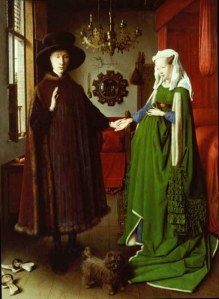
The rooms are old-fashioned but have their charms. Because the keys are skeleton keys, a handsomely-prepared scrapbook in the hotel lobby includes this less than helpful piece of advice: “Tourists spend hours fumbling with old skeleton keys in rickety hotel doors. The haphazard, nothing-square construction of old hotels means the keys need babying. Don’t push them in all the way. Pull the door in or up. Try a little in, quarter turn, and further in for full turn. Always turn the top of the key away from the door to open it. Some locks take two key revolutions to open.” In fact, all you need is patience and roughness; perhaps this is contradictory, but is nevertheless the key to these keys.
Last night, as Jeff went out for a walk, I could hear competing concerts from my hotel window. (Jeff later told me that there were two shows going on at the same time.) Here’s the view from our window:

The music went on until late and unlike in other cities we have visited so far, a lot of people still congregated in the Markt after dusk. There were also a large number of people on the streets relatively early this morning. This is in noticeable contrast to for example Maastricht where the streets were absolutely empty at this hour.
We wanted to see some more paintings by Jan van Eyck and planned to visit the Groeningemuseum. However, when we got there, we discovered that it is closed until October. We wondered why the museum would be closed in the middle of high season and speculated that perhaps something urgent needs to be tended to or there were some complications and the work took longer than expected.
We decided therefore to skip the crowds and go to the nearby city of Ghent. We walked to some interesting places on our way to the train station. For example, here is one of the sets of almhouses that can be seen throughout the city:

We also saw the Minnewater where there were a number of swans. The story behind the swans in the city is an interesting one: “In 1488 the people of Bruges had executed one of the town administrators belonging to the court of Maximilian of Austria, husband and successor of duchess Mary of Burgundy. The town administrator was called ‘Pieter Lanchals’, a name which means ‘ long neck’. The Lanchals family coat of arms featured a white swan. Legend has it that Maximilian punished Bruges by obliging the population to keep swans on their lakes and canals till eternity. Most of these legends and romantic interpretations come from the 19th century. Believe them or not : the beautiful ‘Minnewater’ deserves them.”

We arrived in Ghent at around noon. The city was not as immediately appealing as Bruges. But as we walked deeper, we felt that it was in many ways more authentic than its touristier sister city. In fact, ‘authenticity’ is the catchword that the city is using to label itself for tourists (“Ghent, dazzlingly authentic”). The highlight in Ghent was a visit to Saint Bavo cathedral:
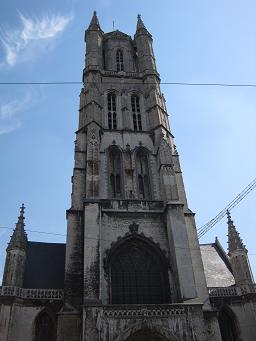
Although admission was free, the cathedral to our eyes was just as grand and interesting as other churches we had paid to gain entrance to. For example, it was as I recall, the first time I saw triptychs in actual use instead of hanging in a museum. It was nice to see these works in three dimensions with the side panels coming out instead of lying flat on a gallery wall. Walking through the church, we saw many paintings, silver items, sculptures, tapestries and other artworks and couldn’t help but marvelled at the grandeur of its original state.
While we were there, someone played the organ which gave the entire place a very Gothic feel. I am sure that in the past, this kind of music was intended to inspire awe or fear in the listeners and to suggest the power of God. The pipe organ was not as grand as the one in the church of St. Bavo’s Haarlem but you could actually see the musician playing in front of the organ. It looked like a very physical activity with many levels of keys and pedals to be manipulated.
The jewel of Saint Bavo cathedral of Ghent is the famous “Adoration of the Mystic Lamb” (1432) by Jan and Hubert van Eyck. The piece is commonly considered to be one of the most impressive artistic masterpieces in Belgium as well as an influential painting of the Middle Ages. This is part of it from the lower central panels:

Tomorrow, we are off to Brussels for the last stop on our brief Benelux tour. But before we go, we hope to take an early morning walk around Bruges to catch the city before it fills up with other temporary (liminal?) residents.
One thing we have noticed during our short stay in Luxembourg is that people seem to be noticeably friendlier than in the Netherlands. Of course, we are only speaking to people whose job it is to be friendly and helpful. But in Luxembourg they seem to be friendlier and more helpful than in other places. It feels like they go beyond what would be necessary to be of service.
Luxembourg may have the best transportation deal in the European Union for only €4 you can travel anywhere in the country on any form of publication transport for an entire day. By London’s standard, this equals the greatest deal of all time. For example, for me to travel from Greenwich to the Strand and back cost £3.5 (this means I need to walk about twenty minutes each way, skipping the tube). It is common for Londoners to take perverse pride in the inefficiency and obscene cost of public transportation. However, it is much more pleasant to actually travel on publication transportation that is affordable and efficient.
Another observation that I had with travelling in the Netherlands and Luxembourg is that the language Dutch is much closer sounding to English than French. When I was in the Netherlands, I often thought that I was listening to English when indeed the people were speaking in Dutch. This is of course because English and Dutch share West Germanic ancestors.
Yesterday, I related a sequence of events which included the death of my camera. Last night, when we returned to our room, I took out the camera recharger to prepare for the next day’s photography. Jeff asked what the charger was for, and I responded for the camera. Jeff had to remind me that the camera was no more. Phantom electronics. Since we still have two more stops and I have recently purchased a Flickr account, not having a camera was a dismal prospect for me to entertain. This morning, we broke down and bought a new camera. Jeff convinced me that finishing our vacation without a camera would be unthinkable for me. Funny how neither of us thought it was more important to know the time.
After buying the new camera, we took first a train and then a bus to a nearby village called Dillingen. Here we rented a kayak to float down the River Sure to Echternach. The company was swamped with campers who were staying in the countryside near the river. Although I didn’t think the river was very busy, Jeff said that it felt we were on a freeway. I guess he is used to paddling in the empty spaces of Canada. Despite the crowds, it was a very pleasant day, especially since the section of river we travelled was very beautiful. Every once and a while, we would see swans and ducks. I often dipped my fingers into the cool water until a nest of seaweed threatened to capture them forever. I admit Jeff was doing all the work, as I sat in the front and finished The Underground Man. We finished two hours later in Echternach, a pretty but touristy village. From here, we caught the bus back to the capital. Unfortunately, we couldn’t take pictures during the kayaking because the camera had to charge for several hours before it could be put into use.
However, when we returned to the hostel, we were able to take some pictures. Here’s the view from which I am blogging:

Tomorrow, we leave the Duchy of Luxembourg for Bruges. That will mark the beginning of the end of our journey.
“The city, too, bombards him. He sees decades and centuries, poverty and wealth, grace and vulgarity. He sees a kaleidoscope of time and mood: buildings that ape Gothic cathedrals, that remember Greek temples, that parade symbols and images. He sees columns, pediments and porticos. He sees Victorian stucco, twentieth-century concrete, a snatch of Georgian brick. He notes the resilience and tenacity of the city, and its difference.” —Penelope Lively‘s City of the Mind (p. 3)
This morning, we left Maastricht early to catch the train to Luxembourg City, the country with the highest GDP per capita. We ate breakfast on the train. Although simple, it was quite satisfying:

We had several transfers including this one at Liège-Guillemins, which is pictured below:

We arrived in Luxembourg City around one o’clock. We took a bus to our hostel. The driver was very friendly and explained to us how efficient the public transport system is in the country and that people don’t really need to buy cars but still do because the low taxes leave them with a lot of disposable income.
The hostel is found in the lower part of the city, Luxembourg being divided into a lower section in a deep river valley and an upper section found on top of the old city walls. The hostel is very modern and is more like a serviced apartment than an old-style hostel. We had a piece of good luck at the check-in counter: some previous guests had left their partly used internet card at reception for the next people to use. The card still had two days left so we will be surfing for free while we are here. This made a nice change from our previous questionable internet experiences. Many places have claimed to have wireless access but in fact their internet connections were very sketchy, especially in the rooms. It is fair to say that a formerly unwritten part of our journey has been a constant quest for internet.
After checking in, we went for a walk around the city. We started by walking along the old city walls. From here, there were incredible views of the Grund, an old section of the city found below the walls. There were also lovely views of the numerous bridges which take traffic and trains into the raised upper city. Some of these bridges were exceptionally tall and their construction seems amazing since they were clearly built a long time ago:

Luxembourg City is outstandingly picturesque. Indeed, it at times seems to be made up entirely of three-dimensional postcards. I have heard Europe described as a living museum and I would say that Luxembourg is one of the most obvious examples of this. Unfortunately, we cannot offer you many images of our own because of what occurred about half way through our city tour.
The series of unfortunate events began in a cafe. Jeff and I were having a drink when I passed him my watch to show him a crack that had developed in the winding button. As he handed the watch back to me, he accidentally dropped it into my coffee. The offending cup is shown below:

The watch worked for a few more minutes after we had cleaned it off. But it eventually died. We headed down from the upper city to a park in the valley. The views were beautiful. However, I was too distracted by my watch and the noseeums which blanketed the sky. At this point, our luck turned from bad to worse. I was swatting away the bugs when I accidentally let go of my precious camera. It smashed onto the ground and was clearly broken. Two severe deaths in less than an hour.
We returned to the hostel disappointed and grumpy (especially me). While I checked email, Jeff went out for a walk. There were not many restaurants around the hostel but he luckily stumbled upon a small Chinese place called Jin Fu. He brought me to it for dinner. There were a handful of locals drinking in the bar section of the restaurant but we were the only true diners and as such were placed in the otherwise empty dining hall.
There were some mild communication problems between Jeff and the waitress as the waitress’s French wasn’t very good. Fortunately, we realised that the waitress could speak Mandarin and from then on it got much easier to talk to each other. The waitress seemed very happy to speak to a customer who could talk to her in Chinese. I decided to have a set meal which included a sweet-and-sour soup, spring rolls and a chicken dish with Chinese mushrooms and bamboo.
I had a Proustian moment when tasting the soup. It reminded me of the kind of soup my deceased grandmother used to make, and I couldn’t help tearing up. I could never have imagined someone else would be able to make the exact same flavour as she did: the subtle taste of sweetness and sourness, the whipped eggs, and the traditional assortment of vegetables. Perhaps the traditional Chinese background music helped forster this sense of nostalgia in me. A musical note, a taste, a smell — the smallest things can conjure up the deepest emotions. The following dishes were also excellent. The spring rolls were huge and crispy and made with very fresh ingredients. The chicken and fish we had were both exceptionally delicious.
While we were eating, the owner and then later, the chef came out to meet me. When I complimented the cook on his food, he was very happy but was also a bit shy. He explained that it didn’t matter how well he cooked, people in the area only came to drink. When he departed our table, he said, ‘We Chinese eat things hot, so I’ll let you finish your meal.’ This is something I have not heard for about a year now, as my parents are not here to reprimand me for eating too slowly.
I left the restaurant both heartened and sad. These mixed emotions seemed to be an appropriate ending for a day filled with such ups and downs.
Maastricht is the first European city I feel sad to leave. It is a truly stunning, romantic and unforgettable place. It feels collectively owned and yet strangely at various moments you can feel it is solely yours, especially early in the morning and the hours after dinner, when the streets are deserted by day tourists.
In retrospect, Middelburg had been the middle of our trip both figuratively and temporally. I say this because Maastricht did not feel like the other Dutch cities we had visited, so in some sense it felt like we left the Netherlands when we left Middelburg.
Our second day in Maastricht was very eventful. We left the hotel to search for breakfast at around ten. It was raining a little, few shops were open. On the cobbled and wet streets, we walked and walked, only interrupted by the occasional tourists. They too must have been searching for a place to have a coffee and breakfast. The city seemed to have turned into a beautiful museum overnight and had not yet opened.
Finally, we found a cafe near a local church. We sat under the umbrella as it caught the rain. At around eleven o’clock, we witnessed people attending mass streaming out of the church – a collection of mainly elderly citizens. And for fifteen minutes, the bell continued to toll. Basking and freezing in the ambience, we had coffees, ham & cheese sandwiches. The rain was not letting up, but we hoped for the best.
At one o’clock, we joined a boat excursion on the River Maas which brought us to St. Pietersberg, the marlstone caverns underneath the hill. The similarity between the name of the river and town is no coincidence, as the name of the city means “the crossing of the Maas”. To get to the caves, we had to climb a hill to a nineteenth-century restaurant, which was still running today. We met the tour at the restaurant. There were two tours and fortunately being non-Dutch speakers proved to be an advantage as the English tour was much smaller in size. The guide handed the entire group (twelve people) three lanterns and gave us directions to the mouth of the caves.
The guide then met us at the entrance. From this point, we entered a wonderful and surreal world. It was pitch black down there except the lights of our lanterns:

It was also chilly enough for us to see our breath. At one point, the guide calculated the humidity by shining his flashlight into the air and checking the density of the mist. I had to put on not only a thick jacket but also my mittens.
The caves turned out not to be caves at all, but mines which had been dug around four hundred years ago. We learnt that people had been mining limestone in the area since the Roman Empire. Although lost in the Middle Ages, the technology for cutting into the hills eventually returned. The caves we entered had been used for cutting giant limestone blocks to be used in household construction. The guide explained that most of the blocks were used to build lower-class housing, the higher classes preferring to use more expensive stones from elsewhere to build the fronts of their houses. However, they were still willing to use the limestone to build the sides and backs of their mansions. In this way, they could use the lower-class (and cheaper) limestone while still saving face at the front.
The guide explained that if people knew that they were mines they would not be interested in visiting so the tourist information described the area as caves. This was actually quite an old ruse as tour guides had been describing the place in romantic terms for hundreds of years. Our guide actually saw himself as part of this long tradition and told us how in the nineteenth century, guides had attracted people to the caves using the same romantic terminology. They carried long poles with lanterns on top and met wealthy strangers on the streets. Here, their poles would inevitably draw attention and they would start up conversations with their potential customers. The image of a man holding a pole with a lantern has become the symbol of the modern-day tour guides. Our guide proudly showed us this image on the lapel of his jacket.
Our tour started much as they had a hundred and fifty years ago. The guide showed us a “welcome painting” which had been painted in the nineteenth century to welcome tourists to the mines. The image featured Dutch, French and German flags but the Dutch, French and English word for “Welcome”. The guide explained that the discrepancy between the flags and the languages was the result of the Second World War. After WWII, the guides had changed the sign from the German for “Welcome” to the English version. However, they had not changed the flag. Our guide explained that the Welcome sign had been a preface for an elaborate series of paintings used by earlier guides throughout the caves. Nineteenth-century guides had taken their customers to interesting parts of the mines; their routes inevitably passed by paintings which were advertisements for the commercial products of the time. They were paid to walk more slowly or to draw their customers’ attention to the paintings on the wall. Below is an advertisement for a chocolate manufacturer:

It must be because of the coolness down there and the fact that the area has not been weathered that these paintings and other artworks were very well-preserved. The above advertisement seemed like it had been painted only recently, but in fact it was quite old.
Throughout the caves, we also saw evidence of earlier tourists who had inscribed their names on the walls. Some of these graffiti dated from the nineteenth century. Much of this historical graffiti was done in a kind of red chalk. We wondered if this chalk had been for sale to tourists at the time. There were also a lot of modern hieroglyphs as well. Seeing these different types of graffiti made one feel like one was walking through history.
Apart from advertisements and graffiti, we also saw a lot of other types of artwork. For example, there was a painting of the Dutch royal family tree and a series of people with hollowed-out eyes. Apparently, hollowing out the eyes allows the artists to give the effect of eyes which follow the viewers wherever they go. We also saw a piece of modern art done by an acquaintance of the guide. The artist had told our guide about the story of creating the artwork shown below. The artist had called on favours from a bunch of other people to gather the materials necessary: a map of the caves, a store of beer and some lights. The work features both carvings into the cave wall and paintings. The story goes that ten days after he had finished the work, someone called him to say that the piece was covered in fungus. The mushrooms were eating the organic components of the child-friendly paint he had used. Even years later when the artist recounted the story, our guide claimed that he was almost in tears. The paintings were in the end saved by the artist’s girlfriend, who told him to simply remove the fungus with a pencil. The fungus has not returned to this date, perhaps because all the organic components were consumed a long time ago.

Speaking of mushrooms, our guide explained that the caves had also been used to grow high-end mushrooms in the 1970s. The caves were perfect growing environment for the mushrooms which were much tastier but less attractive-looking than mushrooms grown in modern farms. Our guide described modern mushrooms as tasting like ‘plastic foam’. However, I was a little sceptical as he then went on to promote cave mushrooms grown elsewhere in the country. Was he in the pocket of the cave fungus industry?
Or maybe it was the flint industry. Our guide seemed to be constantly trying to create sparks with his iron against the flint stone found throughout the cave. The miners had had to use different tools to cut the lime and the flint. The lime could be cut with metal saws. However, when they hit the flint, the saws became instantly blunt. We could see the different styles of cut in the rock. Our guide explained that below the floor the variation between layers of limestone and flint became too close together for mining to be economical.
Undoubtedly, the most interesting story of the mines was their planned use during the Second World War. Local officials had intended to use the area as a safe haven for people during bombing raids. There were numbers painted on the walls which were designed to direct people from different regions to their allotted sections. The officials even had a system of pumps built which took water from beneath the caves and stored it in large cisterns throughout the cave system. There were also plans to build bakeries and churches. Although the mines never protected the 20, 000 people they were designed to shelter, around 2000 people did take refuge there during the allied liberation. While they waited for the arrival of the Canadian and the American forces, they managed to build some chapels, below is one of them:
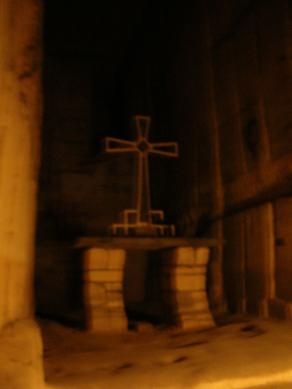
On the boat back to the city, I opened my book The Underground Man by Mick Jackson. I was immediately aware of the similarity between the novel, which features the story of an eccentric Victorian aristocrat who built tunnels under his property, and what we had just seen.
After the tunnels, we returned to our hotel for a brief rest before heading out to have dinner at Mestizo, a Spanish-Mexican restaurant. We were offered two shot glasses of mushroom soup as an Amuse Bouche. The soup was very rich and delicious and it had the intended effect of stimulating our appetites. I had lamb stewed with paprika, sausage, tomatoes, and herbs. Jeff had chicken stuffed with Serano ham and cheese. My dish came with a side order of Mexican rice, which even I found spicy. I think it must be too hot for many of the people who come into the restaurant. The food was served surprisingly quickly for such a nice restaurant. Perhaps the chef wanted to go home early on a Sunday night.
After dinner, we took one last walk through the city. And it was with sadness and admiration that we saw its lovely streets one last time:

Right before our hotel, we saw the scientist Johannes Petrus Minckelers (the man who invented the gas light) holding his eternal flame at dusk. It was a fitting echo of the lanterns of the nineteenth-century tour guides. It was also a fitting farewell:


Late this afternoon, we arrived in Maastricht, the city furthest south in the Netherlands, and is also one of its oldest. It is located near both the German and Belgian borders, which gives Maastricht a cosmopolitan feel. According to Lonely Planet, “No Netherlands itinerary is complete without visiting Maastricht.” For once, they were right. From the second you left the train station, you could feel a vibe in the city quite unlike in any other Dutch cities we had visited so far. A closer inspection of the city showed the place to be intriguing, beautiful and fashionable. Every street seems to offer a new atmosphere or interesting sight. It is perhaps due to its mixture of buildings from different periods and styles. As we walked through the city, we moved from shopping districts which had the energy of Causeway Bay to the quietest European alleys. The city in a way feels like a pastiche of all things and yet unlike postmodern pastiche which can feel artificial and forced, the streets of Maastricht flow into each other naturally.
We first dropped off our bags at our hotel, Matuchi. Then we started our early evening stroll in the city. Our hotel is on the Markt; from there we walked to the square of Vrijthof. Off the square are two impressive churches, Sint Servaasbasiliek and Sint Janskerk. Although smaller, Sint Janskerk is probably more memorable as its tower is made of bright red stone which really stands out in the Maastricht skyline. Below you will find a picture of Sint Janskerk:
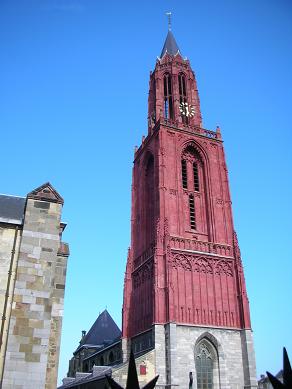
After the square, we walked through some quieter parts of the city. Every corner seemed to have a new surprise. Eventually, we made it to Helpoort, the oldest surviving town gate in the country. We walked through the gate and then came upon a park which followed the old town walls. The park has a mini zoo which houses an eclectic collection of animals including ducks, geese, chickens, deer and goats. At the end of the park, however, we were greeted by a disturbing surprise. Inside a cage which formerly held live bears, we found a rather unnerving piece of public art. The work featured a number of extinct or close to extinct animals as well as a woman tending to a dying giraffe. The meaning of the artwork was obviously intended to raise awareness for endangered species. Its placement at the end of the zoo was probably also designed to admonish people for the causal attention they have paid to various animals in the earlier section of the park. The fact that all the animals in the bottom of the cage stare upwards with wounded gazes made one uncomfortable. Here are some of these animals:



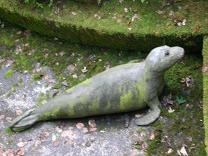

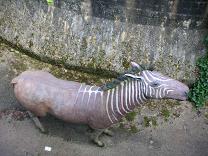

Perhaps we too are guilty of apathy as on the way back to the hotel, we stopped for ice-cream at a beautiful Gelato shop called Luna Rossa. The ice-creams on display were works of art themselves and the cone we enjoyed was rich and creamy:

More about Maastricht tomorrow.
One day, we visited Rotterdam, the second largest city in the Netherlands. We took a double-decker train (all trains here are double-decker):
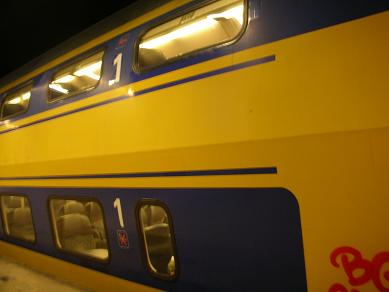
Rotterdam is one of the largest ports in Europe. Much of it was destroyed during WWII, so there is not many historical buildings left, at least in the centre where we were. Instead, it was rebuilt with a range of modern buildings. It has become well known for some interesting architecture, which we walked around to see. We got out at Blaak Train Station. Near the station is a famous set of apartments called “The Overblaak development”. It was built between 1978 and 1984 and designed by Piet Blom. The development features a pencil-shaped tower and some apartment buildings which look like balancing cubes. Below are two images of it:


After that, we crossed a long bridge called Willemsbrug, built in 1981. The bridge is coloured red and is quite striking. It leads from the main land to an island called Noorder Eiland:

While crossing the bridge, I was amazed by the layers of clouds seen in the sky. I have tried to capture the look below:

Jeff thinks that the sky here is so big because the country is so flat. He finds it reminiscent of the sky in the Canadian prairies. I think another reason for such a clear sky is that there is much less pollution here than either in Hong Kong or in London.
On Noorder Eiland, we looked at another bridge called Erasmusbrug, which the locals apparently call “The Swan”. I think you can see the resemblance below:

From the island, we also saw the KPN Telecom headquarters. The building is designed to look like it is leaning forward and resting on a giant white column. It was designed by Renzo Piano, whose work we also saw when we visited the Pompidou Centre in Paris:

After this, we returned to Middelburg via Rotterdam Centraal Station. Near the station is the Nationale Nederlanden skyscraper, the tallest building in the Netherlands, although in Hong Kong it would barely be noticed. There was a nice reflection of the sky on the twin buildings. From the below picture you can see how the buildings seem to blend into the background:

Despite its interesting buildings, Rotterdam did not prove to be instantly likeable to us. Perhaps it is the modernity of the city which makes it feel unwelcoming or more like a city anywhere in the world. I wonder if we would have liked it more had we stayed for the evening and enjoyed the city’s famous night life. Considering how much I like going to bars, I think not.
On Saturday, we left Middelburg for Maastricht. We were lucky enough to get a weekend deal, which meant that we could take first class for less than the cost of second class. When the ticket man explained the deal to us, he said, ‘The only thing is you have to take first class.’ as if it was a kind of compromise we had to make. We said, ‘Oh, even better’, which he echoed and then we all laughed.
On the way to Masstricht, we stopped at Breda for a few hours. The town was lovely and elegant. There was a beautiful park between the station and the main market. We walked through the park and had a coffee in the market. From the cafe, we could see this marvellous view of the local Grote Kerk:

More about Masstricht later.
On Tuesday morning, we walked to Amsterdam Centraal Station to catch a train to Middelburg. The city is situated in Zeeland, the region of the country which gave its name to New Zealand. The train ride was generally smooth and uneventful. Jeff and I took the two and a half hours provided by the ride to do some work. Here is Jeff editing the next issue of Cha, which will be made available in mid August:
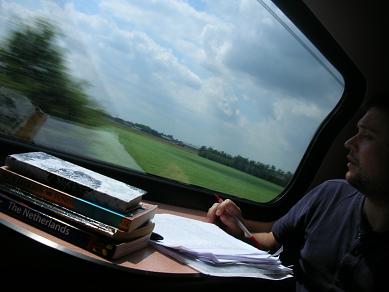
We learnt through some unintentional eavesdropping that there were a number of people on my train who were also going to the PALA conference. Once we arrived, we made our way to the Roosevelt Academy, which is located in the centre of town on the main market square. It is an impressive Gothic building. Here is a picture of the venue and another of me in front of it:


The design on the shutters was not only found on the Roosevelt Academy building, but throughout town. Jeff mentioned that on a bike ride to the nearby village of Veere, the buildings there had a similar yet different design:

After registering, we set up camp in the camp site, which was located about fifteen minutes walk from the centre of town:
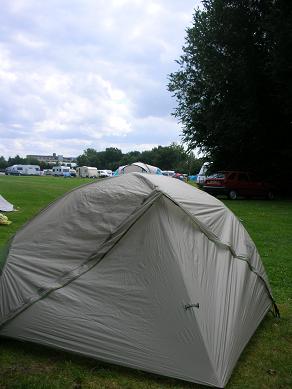
I attended the opening session and the reception before meeting Jeff to have dinner in a well-known local restaurant/bar called “De Mug”:

Although the bar is famous for its wide selection of beer, “De Mug” in the name does not refer to a beer mug, but instead means “mosquito” in Dutch. We ordered two meals: an order of mussels with salad and fries, and some spare ribs. Of course, when we are in Belgium in a few days’ time, we will have mussels again. The portions of our meal were huge and we were unable to finish the food. We actually thought that the mussels and spare ribs in the restaurant were sufficient to feed four people. The huge portions of food were also reflected in the size of their bread:

The picture above was only a display outside a bakery; but the actual size of their bread was equally enormous. Jeff bought a loaf which we ate steadily for several days before we had to give it up having only finish about half.
I have noticed that many Dutch street signs seem to feature a man walking on the post. I guess this indicates that the places on the signs are within walking distance. Here are a collection of these signs from Amsterdam and Middelburg:
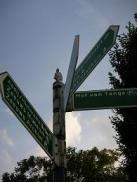


In the Lonely Planet guide, there is a section called “Clichéd Corner”. I was inspired to create my own corner. Being in the Netherlands, of course I have included a windmill and a cow:
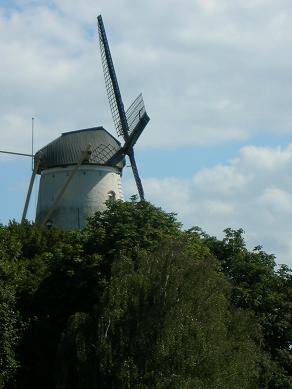
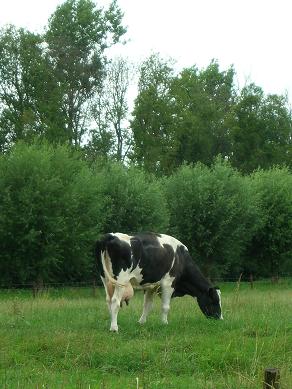
On Saturday, we are leaving for Maastricht.
Please also read Penny Sandford’s comment on the Christian Müller organ. My post contains some factual errors; and Sandford, being a guide in the St Bavo church Haarlem, has kindly corrected my observations.
A distinctive feature of the Netherlands must be its bikes. In fact, bikers seem to rule the streets and sidewalks. Some sidewalks have huge biking lanes which take up three quarters of the path. Pedestrians are confined to a small sliver of concrete:
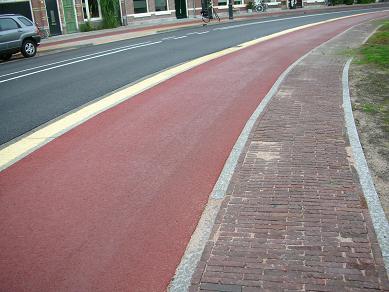
Every once and a while, we will be surprised by the sound of a bell behind us, as we are inadvertently walking on the part of the path belonging to bikers. It would be nice if we too could ride bikes. However, I am unable to ride them as I am very bad at balancing.
Today, we walked to Station Amsterdam Centraal to get to Haarlem, a nearby city. On our way to the station, we passed the Amsterdam Palace:
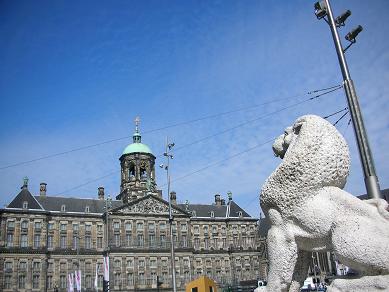
There were also a number of streets featuring Chinese signs. This Chinese area seems to be intertwined with the red light district. I am always amazed by the spread of Chinese culture (especially food) throughout the world:

In Haarlem, we went to Grote Kerk van St Bavo. The church was painted by Pieter Jansz Saenredam in his painting titled “Interior of the Church of St. Bavo in Haarlem”, which we saw in Rijksmuseum yesterday:

Seeing the church itself allowed us to compare the painter’s vision with the real thing. From the picture I took below, it seems that the painter may have manipulated the space a bit to highlight the magnificence of the “Christian Müller orgel“. But we felt that the colours and the contrasts between light and dark in the painting were very close to reality:

According to the museum, the painter had wished to emphasize the grandeur of the pipe organ. Having seen the real object, I can see why he was so impressed with the musical instrument. The Müller organ is considered to be among the most impressive of such organs in the world. The church guide says that “In 1766 Mozart, who was 10 years old at that time, played the Christian Müller organ. Händel played this organ too. The organ counts 5068 pipes and is almost 30 metres high.” When we arrived in the church, the organ was being played and the sound was very heavenly:

While in St. Bavo, I was struck by the contrast between it and Canterbury Cathedral. Canterbury Cathedral was much darker and more ornate; its design a little oppressive. The Dutch church, on the other hand, had a very open and light feel to it. There were huge stained glass windows which allowed a lot of light. The light reflected off the white walls to make the whole church feel welcoming and airy. To me, the Dutch design was much better for bringing people closer to God. To be honest, I was moved to tears by the atmosphere.
For lunch, we first had a coffee near a lovely canal:
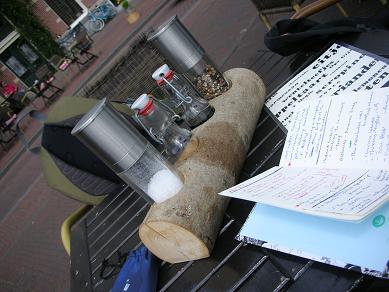
During this time, a nearby bridge turned to allow a number of boats that had lined up to pass. The accumulating bikers on both sides of the road waited patiently, although had they biked about 200 meters down the canal they could have crossed at a different bridge.
After the coffee, we visited Grote market in the city centre. We tried some local snacks such as patat with curry sauce and the famous raw haring; the fish was very yummy indeed. For me, the curry sauce was reminiscent of the sauce HongKongers put on fish balls (I miss HongKong-style fish balls!):


Tomorrow, we will leave Amsterdam for Middelburg.
Last night, we went to an Indonesian restaurant called “Tujuh Maret“. It was on a nearby street and located among several other Indonesian restaurants. The large number of Indonesian restaurants in Amsterdam speaks to former Dutch colonization of Indonesia. The food was excellent, although the service was quite slow. After dinner, we retired for the evening as we had had such a long day.
This morning, we had a large breakfast provided by the hotel and then we walked to Rijksmuseum, which is devoted to the golden age of Dutch art, culture and history:

We were offered a choice of two audio guides: either a historical and formal one or a fun and informal one. I chose the historical one, thinking that they would both cover the same items. However, we later realized that they in fact did not cover all of the same works. The wisest thing to do, if we had known, would have been to have both versions. That said, the historical guide covered many more works and was probably the better choice.
We saw a number of interesting pieces in the museum. One of the obvious stars was a seventeenth-century doll’s house featuring a scale model of a Dutch mansion. All of the furniture and household items (such as silver ware and china) were made of authentic materials by actual artisans. The house of course reminded us of Ibsen’s play A Doll’s House. We also saw another doll’s house which was commissioned by a woman shortly before she got married. The house seemed to portray different aspects of domestic life. We thought that perhaps the woman had commissioned the house so she could practice domestic management prior to getting married.
On an upper floor of the museum, we found the section devoted to Dutch masters such as Rembrandt and Vemeer. One of the pieces by Rembrandt is “Rembrandt’s Mother as Biblical Prophetess Hannah” (1631). I had previously seen this painting on the cover of Nicholas Royle’s book Uncanny: An Introduction and had wondered why the old woman’s face was not painted in detail. Today, I discovered that the focus of the painting was her lined ‘reading hand’:
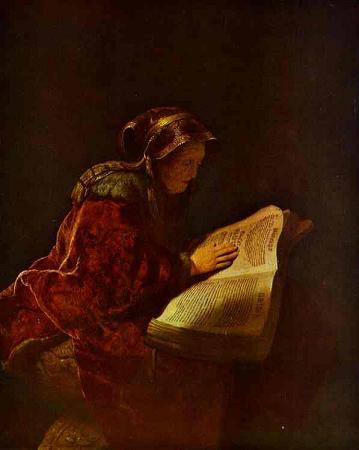
I was also intrigued by a set of portraits. One featured the father dressed in solemn and conservative black. His son, who at the age of twenty was already quite fat, was dressed dandishly in bright clothes and was proudly showing off a pair of fashionable gloves. The description said that the mother had also been painted, but her portrait was now located in Dresden. We felt sorry that the family had been broken up. Lastly, I was struck throughout that all the children were painted as mini-adults. I guess at the time childhood was seen differently and people saw children as simply diminutive grown-ups. Still, in one painting, the true nature of childhood was revealed. It portrayed a winter festival in which children received gifts according to their conduct throughout the year. One child had received a kind of hockey stick and was gloating his gift unkindly to his crying elder brother, who had only received some twigs because he had been naughty. Certainly, sibling rivalry existed even then.
After the museum visit, we again strolled in the city, and this time, we paid particular attention to the canal houses. Unlike London where all the houses on the same street are often identical, the canal houses here show great individuality especially through their different gables. Apparently, people had their houses built in different styles because in the past there were no numbers and the distinct character of a house helped people identify it:
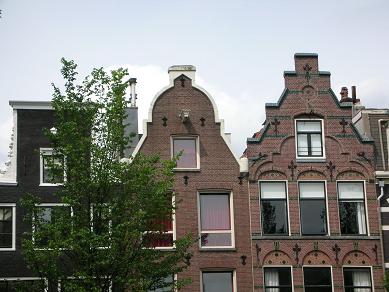
We returned to the hotel for a little while this afternoon to have a picnic (ham, cheese, croissants, chips and soft drinks) on our window latch and watch the boats pass by in the canal. What a busy day, one boat after another — people laughed and sang.
It all began very early this morning. We only had about two hours sleep before getting up and going to London Bridge. The time at which we boarded the train for Gatwick was so ghastly that it does not even exist:

The flight itself could also be discribed as unusual. It was rushed and the air hostesses barely had time to serve coffee before they had to pick up the empty cups.
Once we arrived in Amsterdam, we had to wait a long time for our bags to appear. Not knowing Dutch and feeling a bit tired, the following message on the screen gave us a start. It read: “Alle baggage is gelost”:

It seemed to mean that all the baggage had been lost. But the translation revealed that it actually meant all the baggage had been unloaded. Still, it took another thirty-five minutes from the point at which that message appeared before our bags actually appeared.
We had little trouble getting through the city to our hotel, Hotel Prinsenhof, which was built in the seventeenth century. The hotel is situated in the southern canal belt of the city and is located next to a canal. When we arrived at the hotel, we seemed to be magically welcomed by a self-opening door. We later discovered that it was another set of guests leaving the hotel who had pulled on a rope which opens the top half of the door from the top of the stairs. The rope mechanism seems to have been put in place because the stairs to the lobby are incredibly steep and the staff undoubtedly grew tired of climbing up and down.
Our room (the famous “Room number 9”) is at the very top of the hotel. It has beautiful beams in the ceilings and a short ladder which leads to the window from which we have excellent canal views:

After settling in, we went for a walk. We headed north through Waterlooplein, and then into the red light district. The district is famous for its coffee houses selling soft drugs and its brothels featuring women on display in windows. We did not stay there for long.
After the madness of the red light district, we walked to the more elegant area of Jordaan where we had coffee on the street from a little restaurant. The location of the restaurant proved good for people-watching and we saw a number of flamboyant cars and some people moving to the top floor of a nearby house. The style of moving was very interesting. Here is a picture:

Again, we see people using ropes to avoid the stairs.
After coffee, we walked through Jordaan back to our hotel. In the more fashionable districts we passed, it was often hard to tell if a ground level flat was a home or a gallery. Not only were they fashionably designed, but people seem to leave their curtains open as if they wished to display their homes.
(There are some more pictures of Amsterdam on my Flickr page. This photography blog will be updated with new images frequently.)